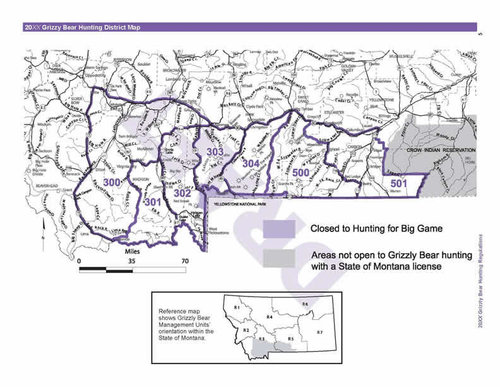http://www.bozemandailychronicle.co...cle_b5e28b83-da08-597b-9930-b869fc285191.html
Very odd dates. Was that the plan all along Fin?
State wildlife officials have released a draft of the grizzly bear hunting regulations they hope to implement if the federal government is successful in removing Endangered Species Act protections from the bears.
Montana Fish, Wildlife and Parks is proposing spring and fall hunting seasons in seven hunting districts near the border of Yellowstone National Park between Interstate 15 and the western border of the Crow Indian Reservation. Each district, called Grizzly Bear Management Units, will have a quota on the number of bears that can be killed.
FWP spokesman Ron Aasheim said the proposal will fulfill a U.S. Fish and Wildlife Service requirement that state management plans be in place as part of the move to delist the bears. USFWS released a draft delisting proposal in March, and officials hope a final delisting rule will be finished by the end of the year.
State plans are expected to be included in the final proposal, though no state hunting will occur until the bears are delisted. FWP’s release of the plan on Wednesday gives people a first glimpse of what the state might do.
“This is a first attempt at hopefully a management option that we’re going to have here down the road,” Aasheim said.
The Montana Fish and Wildlife Commission will hear the FWP proposal at its meeting next week and will take an initial vote. If approved, it will then be open for public comment.
Grizzly bears haven’t been hunted in Montana in decades, and have been listed as a threatened species since 1975. The bears were briefly delisted in 2007, but a lawsuit from environmental groups led a federal judge to restore the protections.
USFWS’ new delisting plans include limits on the number of bears that can be killed within a 19,279-square-mile area that covers Yellowstone and parts of all three states. Caps on how many bears can be killed will depend on population estimates within that same area and will be split between the states.
Under a draft agreement — which the commission will also vote on next week — Wyoming would get 58 percent of the total, Montana 34 percent and Idaho 8 percent.
Montana’s draft regulations don’t say what the quotas will be in the different hunting units because they aren’t sure how many bears they might be allowed to take. A memo explaining their proposal said FWP expects Montana’s share to be fewer than 10 and potentially zero in some years.
The fall season would run from Nov. 10 to Dec. 15, and the spring season would run from March 15 to April 20. Aasheim said those dates are meant to ensure that mostly male bears are available for hunters. Females tend to enter dens before males and emerge later, and the state based those dates on research done in the Yellowstone region.
Other measures meant to protect females and young bears from hunters include requiring that grizzlies killed are alone and not with any other bears.
The number of licenses will be limited based on the bear quota, and hunters who draw a license will have to wait seven years before drawing another. Grizzly license holders will be required to take a course in bear identification, both for the differences between black and grizzly bears and female and male bears.
License prices are set by the Montana Legislature, and FWP pulled prices from decades-old grizzly bear hunting regulations for the draft versions. If a hunting season were to happen, residents would pay $150 for a grizzly tag. If they are successful, they would pay another $50 for a trophy license which allows a person to possess and move a trophy animal. Non-resident hunters would pay $1,000 for a tag, and their trophy licenses would also be $50.
Nick Gevock, the conservation director for the pro-delisting Montana Wildlife Federation, said his group likes the draft hunting regulations and he believes they will prevent hunters from taking too many bears.
“I think the agency has put in a lot of safeguards to ensure we don’t have an overharvest,” Gevock said.
On the other side, the Sierra Club’s Bonnie Rice was critical of the proposed regulations. She opposes the hunting of grizzlies and the delisting because she thinks the population is still vulnerable.
Rice noted that 61 bears were killed last year when no hunting took place, and she said beginning hunting when the death numbers are that high is “completely misguided.”
She added that she is worried that the state didn’t directly address habitat connectivity for the bears — the idea of grizzlies from the Northern Continental Divide and Yellowstone intermingling. Many grizzly advocates and biologists say connectivity is vital to their long-term viability, and Rice wants to see more done to ensure that happens.
“There’s nothing in this proposal to ensure that that connectivity can happen,” Rice said.
Very odd dates. Was that the plan all along Fin?





